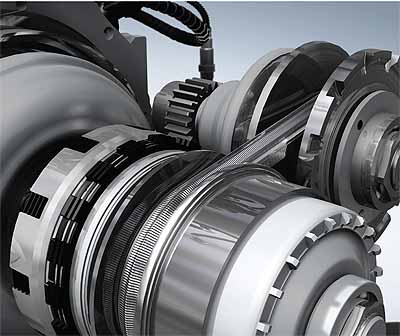Bosch VDT
Bosch is ahead of the field
Bosch Van Doorne’s Transmissie (Bosch) develops, manufactures and sells marketleading pushbelts for use in Continuously Variable Transmission (CVT), an innovative automatic transmission system for the automotive market.
The company, which has many years experience in its field, is the industry leader in the development of CVT pushbelt technology and in May this year produced its ten-millionth pushbelt. Through its various development programmes the company is keen to demonstrate the advantages of CVT technology to the modern automotive industry.
The company has a strong heritage and tradition, and vast experience, both in the entire CVT design as in the manufacturing of a range of pushbelt designs. The business has its roots in the development of the first pushbelts in the Netherlands in the late 1950s by Dr. Hub van Doorne. Later, in 1972, Van Doorne established a manufacturing facility called Van Doorne’s Transmissie BV to produce the pushbelts. Following extensive expansion – the company was producing around 250,000 units per year in the 1990s – Van Doorne’s Transmissie was taken over by the Bosch Group in 1995. This takeover encouraged the development of the second-generation pushbelt, and from 1997 onwards, the company focused on the production of pushbelts for high torque applications. Nowadays the focus is also very much on emerging markets like India and China.
As the company is currently the leading figure in research and development in the field of CVT, the popularity of its product is no surprise, as indicated by the amount of CVT pushbelts produced every year. In 2000, Bosch produced 400,000 pushbelts, and this figure rose to 1.6 million in 2006. It is estimated that by the end of the year, production of Bosch’s CVT pushbelts will exceed two million units.
CVT has become a central technology in the drive to reduce CO2 emissions, as well as to lower fuel consumption. In 2006, worldwide installation of CVTs in the automotive industry reached the level of 2.5 million units per year. Bosch estimates that by 2010, this figure should reach five million, and then eight million in 2015, across the world market.
CVT technology is successful because of the value and precision it offers customers. Using a stepless shifting mechanism in automatic transmission optimises a car’s engine power. This offers customers increased fuel economy, ultimate driving comfort, maximum power, stepless smooth acceleration and more driving fun.
This is how the CVT works:
A CVT consists of an electronically controlled and oil pressure supported variator. The variator consists of a set of pulleys (primary and secondary) and a high alloy steel pushbelt. The pushbelt is the heart of the CVT and forms the indispensable link between the vehicle’s engine and the driving wheels. The engine’s power is transferred from the primary pulley to the secondary pulley by pushing the CVT belt. By changing the width of the pulleys an infinite number of ratios can be established. The Bosch pushbelt consists of two ring packages of and approximately 400 elements.
The smoothness of the CVT system is caused by the lack of torque interruptions between gear changes. This allows smooth acceleration without jerking motion. At the same time the overdrive mode keeps engine rpm low which also keeps noise levels at a minimum. The CVT is also able to reduce fuel consumption by 15 percent, so it is no surprise that CVT technology is at the forefront of ‘green’ automotive solutions. Throughout the world more than 60 models use the CVT pushbelt, with 14 models available in Europe alone. This figure is expected to continue to rise and CVT technology can be used in all types of FWD cars from small hatchbacks to the largest SUVs. Equally, the CVT technology is non-specific in terms of what fuel is used. This means it can be used in diesel, petrol and hybrid cars.
Bosch works closely together with its customers in the research and development phase of its products. As a Tier 1 and 2 component supplier to OEMs, continuous innovation within the field of pushbelt technology is required and offered. This is particularly applicable in the Japanese market, the biggest investors and users of CVT technology. Japan adopted CVT Technology as one of the best ways to improve fuel economy and to reduce CO2 emissions. Continuous investment will acknowledge Bosch’s position in the international market for the production of CVT pushbelts. Ten million units is only the beginning; as global concerns over the environmental output within the automotive industry increases, it is certain that the solutions Bosch produces will be at the forefront of progress.
Bosch
Products: Continuously Variable Transmission (CVT) pushbelts
Sites: Tilburg, the Netherlands
Employees: 920
www.cvt.bosch.com
